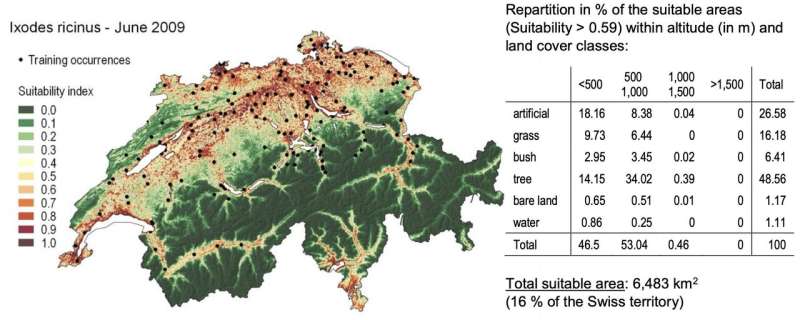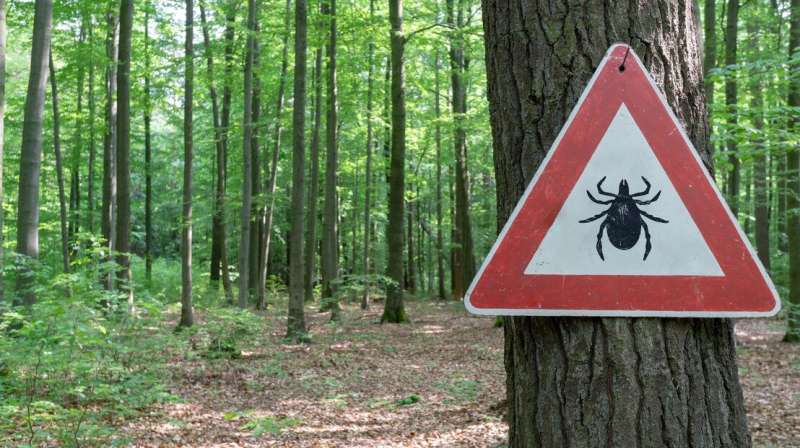Mapping to predict the distribution of ticks in Switzerland

A comprehensive study by EPFL and Lausanne University Hospital (CHUV) has enabled researchers to map the geographical distribution of ticks in Switzerland for the first time, as well as to determine whether they are carriers of chlamydia. Little is known about these bacteria, but ticks can potentially pass them to humans. The team found that zones conducive to tick proliferation have expanded by 10% over the last decade.
Hikers setting out on one of Switzerland's many walking trails often bring back beautiful photos, the occasional cramp and—quite unintentionally—ticks. These tiny acarids, which are present in dense undergrowth and at the edges of forests, are particularly active in hot weather and attach themselves to human and animal hosts passing nearby. Despite their small size, they can transmit potentially serious diseases such as Lyme disease and tick-borne encephalitis. Recent research by the Institute of Microbiology at CHUV has shown that ticks are often carriers of large amounts of chlamydia, a still poorly-understood bacteria that can be passed to humans and cause secondary disease.
Scientists are aware that tick proliferation and activity are influenced by numerous environmental factors, including temperature and humidity. However, data are still lacking on their regional distribution over time in Switzerland, which has been classified as a tick risk area. At EPFL's Laboratory of Geographic Information Systems (LASIG), Estelle Rochat's thesis project set out to address this lacuna and to identify areas where ticks carry chlamydia. Her extensive mapping work has been published in the prestigious Applied and Environmental Microbiology.
Three data sources
After identifying the environmental conditions that are conducive to the presence of the castor bean tick (Ixodes ricinus), Switzerland's most prevalent tick species, Rochat generated maps of their geographical distribution between 2008 and 2018. She drew on three databases: a 2009 field campaign carried out by the Swiss Army, during which more than 60,000 ticks were collected and analyzed; thousands of entries into a smartphone app that allows users to indicate where they observed ticks; and a tick collection project led by Rochat in 2018.
She then used machine learning (a form of artificial intelligence) to predict the probability of ticks and bacteria being present based on values taken from a set of environmental data (rainfall, temperature, humidity, etc.) in the vicinity of collection points.
The machine learning program allowed Rochat to estimate the ticks' locations, and revealed that the surface area of zones propitious for tick propagation grew from 16% of Switzerland's land mass in 2008 to 25% in 2018.

The scope, originality and fresh approach of Rochat's research drew praise from Gilbert Greub, a world-renowned expert in chlamydia and ticks and Director of the CHUV's Institute of Microbiology. "This is a landmark project, and contains sufficient detail at national level to allow us to draw conclusions. We can clearly see that between 2008 and 2018, there was an increase in high-risk tick exposure areas, which I believe is a reflection of global warming. It shows that ticks have migrated 300–400 meters higher up in subalpine zones."
For Greub, the study is a valuable tool for prevention purposes, as well as for awareness-raising. In addition, it will be useful at the Institute, which is conducting clinical studies on the impact of tick-borne chlamydia on humans.
Rochat's model is now available in open access and can be used in future research on other tick-borne pathogens. "It's extremely interesting to see how ecological niches overlap. We used chlamydia in this case because we were working with Gilbert Greub, a global expert, but our approach can also be applied to tick-borne encephalitis and Lyme disease. The algorithms needed to crunch through environmental data are freely available and can be applied to other datasets," says Stéphane Joost, who supervised Rochat's thesis at LASIG.
Joost sees an opportunity for the Swiss Federal Office of Public Health to fine-tune its risk maps for ticks—which will be increasingly present in Switzerland as a result of global warming.
More information: Estelle Rochat et al. Nested species distribution models of Chlamydiales in tick host Ixodes ricinus in Switzerland, Applied and Environmental Microbiology (2020). DOI: 10.1128/AEM.01237-20
Journal information: Applied and Environmental Microbiology
Provided by Ecole Polytechnique Federale de Lausanne





















